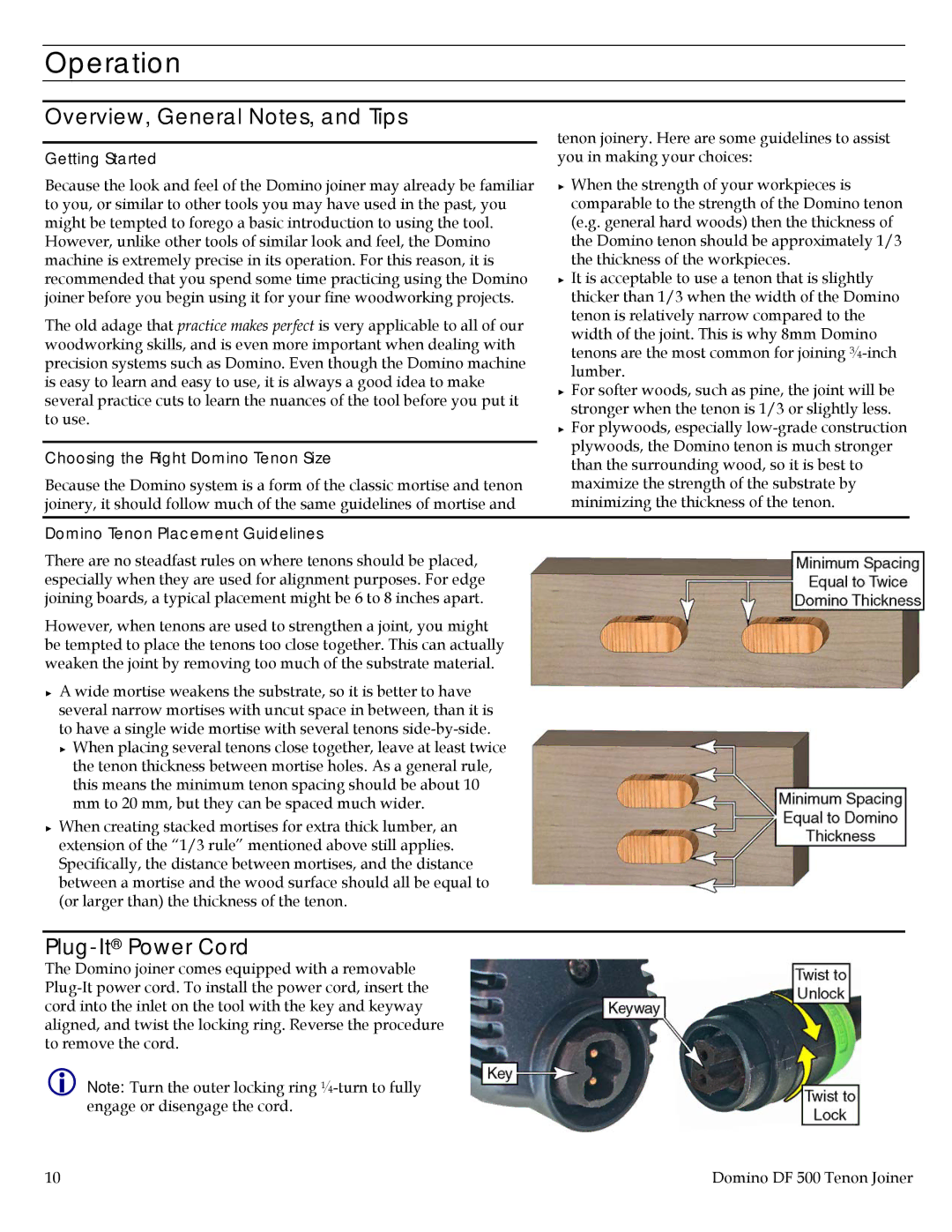
Operation
Overview, General Notes, and Tips
| tenon joinery. Here are some guidelines to assist | |
Getting Started | you in making your choices: | |
Because the look and feel of the Domino joiner may already be familiar | ► When the strength of your workpieces is | |
to you, or similar to other tools you may have used in the past, you | comparable to the strength of the Domino tenon | |
might be tempted to forego a basic introduction to using the tool. | (e.g. general hard woods) then the thickness of | |
However, unlike other tools of similar look and feel, the Domino | the Domino tenon should be approximately 1/3 | |
machine is extremely precise in its operation. For this reason, it is | the thickness of the workpieces. | |
recommended that you spend some time practicing using the Domino | ► It is acceptable to use a tenon that is slightly | |
joiner before you begin using it for your fine woodworking projects. | thicker than 1/3 when the width of the Domino | |
The old adage that practice makes perfect is very applicable to all of our | tenon is relatively narrow compared to the | |
width of the joint. This is why 8mm Domino | ||
woodworking skills, and is even more important when dealing with | ||
tenons are the most common for joining | ||
precision systems such as Domino. Even though the Domino machine | ||
lumber. | ||
is easy to learn and easy to use, it is always a good idea to make | ||
► For softer woods, such as pine, the joint will be | ||
several practice cuts to learn the nuances of the tool before you put it | ||
stronger when the tenon is 1/3 or slightly less. | ||
to use. | ||
► For plywoods, especially | ||
| ||
| plywoods, the Domino tenon is much stronger | |
Choosing the Right Domino Tenon Size | ||
than the surrounding wood, so it is best to | ||
| ||
Because the Domino system is a form of the classic mortise and tenon | maximize the strength of the substrate by | |
joinery, it should follow much of the same guidelines of mortise and | minimizing the thickness of the tenon. | |
|
| |
Domino Tenon Placement Guidelines |
| |
There are no steadfast rules on where tenons should be placed, |
| |
especially when they are used for alignment purposes. For edge |
| |
joining boards, a typical placement might be 6 to 8 inches apart. |
| |
However, when tenons are used to strengthen a joint, you might |
| |
be tempted to place the tenons too close together. This can actually |
| |
weaken the joint by removing too much of the substrate material. |
| |
► A wide mortise weakens the substrate, so it is better to have |
| |
several narrow mortises with uncut space in between, than it is |
| |
to have a single wide mortise with several tenons |
| |
► When placing several tenons close together, leave at least twice |
| |
the tenon thickness between mortise holes. As a general rule, |
| |
this means the minimum tenon spacing should be about 10 |
| |
mm to 20 mm, but they can be spaced much wider. |
| |
► When creating stacked mortises for extra thick lumber, an |
| |
extension of the “1/3 rule” mentioned above still applies. |
| |
Specifically, the distance between mortises, and the distance |
| |
between a mortise and the wood surface should all be equal to |
| |
(or larger than) the thickness of the tenon. |
|
Plug-It® Power Cord
The Domino joiner comes equipped with a removable
Note: Turn the outer locking ring
10 | Domino DF 500 Tenon Joiner |
